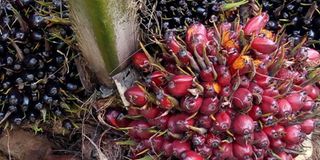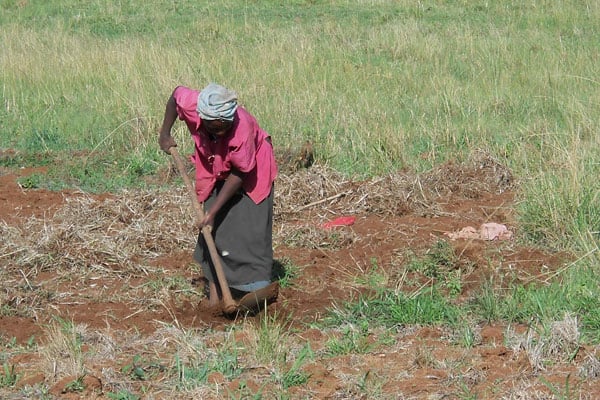Prime
How you can grow oil palm this rainy season

Palm oil tree will bear fruits three years after planting. Photo/Courtesy
What you need to know:
- Palm oil trees are native to Africa, especially West Africa but were brought by travellers to South East Asia over 100 years ago as an ornamental tree. The Asian countries have since taken over farming it as commercial crop on large scale making more than 85 percent of the global supply of products developed from the plant.
In Uganda, oil palm is not a native crop though it has been grown as homestead decoration in homes and church premises for a long period of time.
However, in the 1990’s Uganda government with support from World Bank and the United Nation’s International Fund for Agricultural Development (IFAD) began to set up a national vegetable oil development programme where the main planted crop was oil palm. Oil palm farming has been done mainly under private and public partnership in Kalangala Islands but this can no longer sustain the growing agro industrialisation agenda hence the need to engage farmers across the country to adopt the same.
This was revealed by scientists from the National Agricultural Research Organisation (Naro) during the Naro – Makerere University Conference that took place in Kampala last week with the main theme “Innovations for Enhancing Productivity for Agro Industrialisation.”
Background
Research in palm oil is believed to have started in the 1970’s though the plants were introduced in the country in 1910 with the first varieties brought from Asian countries and planted at the Botanical Garden in Entebbe to establish if it can grow in the country.
However, in 1971 test trials were conducted at the current National Coffee Research Institute (NaCORI) in Kituuza, Mukono District which were later crossed with varieties obtained from Malaysia which farmers in Kalangala Islands have been growing.
Palm oil trees are native to Africa, especially West Africa but were brought by travellers to South East Asia over 100 years ago as an ornamental tree. The Asian countries have since taken over farming it as commercial crop on large scale making more than 85 percent of the global supply of products developed from the plant. In 2003, government took an initiative to increase Uganda’s production in vegetable oil to meet the domestic demand under a public private producer partnership where Oil Palm Uganda Limited was established.
Research initiative
The programme leader oil palm, fruits and vegetables at the National Crops Resources Research Institute (NaCRRI) Dr Gabriel Ddamulira says just like any other plantation crops, small holder farmers require between three and four acres of land to grow oil palm.
It is also important to note that the palms must be of good quality in order to produce enough oil. Every one kilogramme of harvested palm fruit must be able to produce 220 grammes of oil.
Agronomy practices
Dr Ddamulira goes ahead to explain the best agronomy practices farmers engaged in growing the plant must adopt in order to obtain the required yield.
Variety selection
Previously farmers have been growing varieties that were introduced from Malaysia which has since succumbed to Fusarium wild disease.
Dr Ddamulira and team have since developed hybrid varieties were they crossed dura with tenera to come up with pisifera variety which is easily adaptive and high yielding.
Dura fruits have a thick shell and produce approximately five tonnes of oil per hectare per year. They are hybrid varieties obtained from Benin in West Africa were farmers grow all three types of varieties but Pisifera is considered to be producing the highest amount of oil compared to the two.
The scientists brought the pre germinated seedlings packaged in potting bags which were planted and multiplied in Kalangala.
Planting
Nursery preparation involves drying the palm seed and planting them in potted bags. It may take about 12 months to grow at a pre germination stage.
Thereafter farmers can transfer them into a secondary nursery where fertiliser is applied and left to grow for 15 months.
This can then be transferred into the field for planting with spacing of 8.5 by 8.5 metres. Farmers are expected to plant 60 seedlings per acre and apply DAP fertiliser during planting. After four months apply NPK and the last application of NPK can be done after one and half years.
It is at this stage that the trees begin producing fruits which farmers are expected to remove because they are small with less oil content.
Weeding and pruning
The weeding of palm oil plantation is not intensive and farmers can only weed at the initial stages but the moment the plants begin to form canopies, the weeds are usually tinny grasses which farmers are encouraged not to weed because they can hold rain water for growth of the plants.
Pruning is usually done during harvesting because the moment the fruits are being removed, then the canopies are also pruned. The life circle of the plant is 25 years and thereafter they can be cut down and replaced.
Harvesting and marketing
The hybrid variety usually develops the required fruits after growing for three years. Farmers are advised to start harvesting when the fruits turn golden yellow. Each bunch weighs upto 50 kilogrammes upon maturity.
The marketing of the fresh fruits is determined by the marketing committee of the processing company Bidco and the growers trust. In the most cases the price ranges between Shs938 and Shs1,500.
Processing
It must be noted that under the private public partnership arrangement, there are no small scale industries processing and refining palm oil.
The value addition done in Uganda starts with the oil mills that extract crude oil which is fed into Bidco Uganda Limited refinery in Jinja and at Bugala Island where kernel nuts are also crushed. The fibre is used for generating electricity and the nut shells are used as manure in the plantations.




